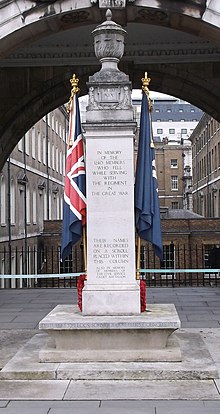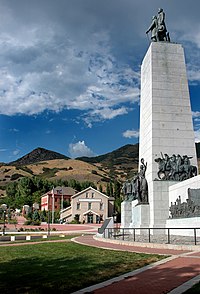Portal:History
The History Portal
History (derived from Ancient Greek ἱστορία (historía) 'inquiry; knowledge acquired by investigation') is the systematic study and documentation of the human past.
The period of events before the invention of writing systems is considered prehistory. "History" is an umbrella term comprising past events as well as the memory, discovery, collection, organization, presentation, and interpretation of these events. Historians seek knowledge of the past using historical sources such as written documents, oral accounts or traditional oral histories, art and material artifacts, and ecological markers. History is incomplete and still has debatable mysteries.
History is an academic discipline which uses a narrative to describe, examine, question, and analyze past events, and investigate their patterns of cause and effect. Historians debate which narrative best explains an event, as well as the significance of different causes and effects. Historians debate the nature of history as an end in itself, and its usefulness in giving perspective on the problems of the present.
Stories common to a particular culture, but not supported by external sources (such as the tales surrounding King Arthur), are usually classified as cultural heritage or legends. History differs from myth in that it is supported by verifiable evidence. However, ancient cultural influences have helped create variant interpretations of the nature of history, which have evolved over the centuries and continue to change today. The modern study of history is wide-ranging, and includes the study of specific regions and certain topical or thematic elements of historical investigation. History is taught as a part of primary and secondary education, and the academic study of history is a major discipline in universities.
Herodotus, a 5th-century BC Greek historian, is often considered the "father of history", as one of the first historians in the Western tradition, though he has been criticized as the "father of lies". Along with his contemporary Thucydides, he helped form the foundations for the modern study of past events and societies. Their works continue to be read today, and the gap between the culture-focused Herodotus and the military-focused Thucydides remains a point of contention or approach in modern historical writing. In East Asia, a state chronicle, the Spring and Autumn Annals, was reputed to date from as early as 722 BC, though only 2nd-century BC texts have survived. The title "father of history" has also been attributed to Sima Qian and Ibn Khaldun in their respective societies. (Full article...)
The St Vincent-class battleships were a group of three dreadnought battleships built for the Royal Navy in the first decade of the 20th century. The sister ships spent their entire careers assigned to the Home and Grand Fleets. Aside from participating in the Battle of Jutland in May 1916 and the inconclusive action of 19 August several months later, their service during the First World War generally consisted of routine patrols and training in the North Sea. Vanguard was destroyed in 1917 by a magazine explosion with the near total loss of her crew. The remaining pair were obsolete by the end of the war in 1918, and spent their remaining time either in reserve or as training ships before being sold for scrap in the early 1920s.
Vanguard's wreck was extensively salvaged before it was declared a war grave. Since 2002, it has been designated as a controlled site under the Protection of Military Remains Act 1986 and diving on the wreck is generally forbidden. (Full article...)

Trinity was the code name of the first detonation of a nuclear weapon, conducted by the United States Army at 5:29 a.m. MWT (11:29:21 GMT) on July 16, 1945, as part of the Manhattan Project.
The test was of an implosion-design plutonium bomb, nicknamed the "gadget", of the same design as the Fat Man bomb later detonated over Nagasaki, Japan, on August 9, 1945. Concerns about whether the complex Fat Man design would work led to a decision to conduct the first nuclear test.
The code name "Trinity" was assigned by J. Robert Oppenheimer, the director of the Los Alamos Laboratory, inspired by the poetry of John Donne.
The test, both planned and directed by Kenneth Bainbridge, was conducted in the Jornada del Muerto desert about 35 miles (56 km) southeast of Socorro, New Mexico, on what was the Alamogordo Bombing and Gunnery Range (renamed the White Sands Proving Ground just before the test). The only structures originally in the immediate vicinity were the McDonald Ranch House and its ancillary buildings, which scientists used as a laboratory for testing bomb components.
Fears of a fizzle prompted construction of "Jumbo", a steel containment vessel that could contain the plutonium, allowing it to be recovered; but ultimately Jumbo was not used in the test. On May 7, 1945, a rehearsal was conducted, during which 108 short tons (98 t) of high explosive spiked with radioactive isotopes was detonated. (Full article...)
The South China Sea raid (designated Operation Gratitude) was an operation conducted by the United States Third Fleet between 10 and 20 January 1945 during the Pacific War of World War II. The raid was undertaken to support the liberation of Luzon in the Philippines, and targeted Japanese warships, supply convoys and aircraft in the region.
After attacking airfields and shipping at Formosa and Luzon, the Third Fleet entered the South China Sea during the night of 9–10 January. Aircraft flying from its aircraft carriers attacked Japanese shipping off French Indochina on 12 January, sinking 44 vessels. The fleet then sailed north and attacked Formosa again on 15 January. Further raids were conducted against Hong Kong, Canton and Hainan the next day. The Third Fleet departed the South China Sea on 20 January and, after making further attacks on Formosa and the Ryukyu Islands, returned to its base on 25 January. (Full article...)
The Pioneer Helmet (also known as the Wollaston Helmet or Northamptonshire Helmet) is an Anglo-Saxon boar-crested helmet from the late seventh century found in Wollaston, Northamptonshire, United Kingdom. It was discovered during a March 1997 excavation before the land was to be mined for gravel and was part of the grave of a young man. Other objects in the grave, such as a hanging bowl and a pattern welded sword, suggest that it was the burial mound of a high-status warrior.
The sparsely decorated nature of the helmet, a utilitarian iron fighting piece, belies its rarity. It is one of just six Anglo-Saxon helmets yet discovered, joined by finds from Benty Grange (1848), Sutton Hoo (1939), Coppergate (1982), Shorwell (2004) and Staffordshire (2009); its basic form is nearly identical to that of the richer Coppergate helmet found in York. Like these, the Pioneer Helmet is an example of the "crested helmets" that flourished in England and Scandinavia from the sixth through eleventh centuries. (Full article...)

The Civil Service Rifles War Memorial is a First World War memorial located on the riverside terrace at Somerset House in central London, England. Designed by Sir Edwin Lutyens and unveiled in 1924, the memorial commemorates the 1,240 members of the Prince of Wales' Own Civil Service Rifles regiment who were killed in the First World War. They were Territorial Force reservists, drawn largely from the British Civil Service, which at that time had many staff based at Somerset House.
Both battalions of the expanded Civil Service Rifles were disbanded shortly after the war; the regiment amalgamated with the Queen's Westminster Rifles, but former members established an Old Comrades Association to keep the regiment's traditions alive. The association began raising funds for a war memorial in 1920, and the Prince of Wales unveiled the memorial on 27 January 1924. It takes the form of a single rectangular column surmounted by a sculpture of an urn and flanked by painted stone flags, the Union Flag on one side and the regimental colour on the other. The base on which the column stands is inscribed with the regiment's battle honours, while an inscription on the column denotes that a scroll containing the names of the fallen was placed inside. (Full article...)
The Roman temple of Bziza is a well-preserved first century AD building dedicated to Azizos, a personification of the morning star in ancient Arab polytheism. This Roman temple lends the modern Lebanese town of Bziza its current name, as Bziza is a corruption of Beth Azizo meaning the house or temple of Azizos. Azizos was identified as Ares by Emperor Julian.
The tetrastyle prostyle building has two doors that connect the pronaos to a square cella. To the back of the temple lie the remains of the adyton where images of the deity once stood. The ancient temple functioned as an aedes, the dwelling place of the deity. The temple of Bziza was converted into a church and underwent architectural modification during two phases of Christianization; in the Early Byzantine period and later in the Middle Ages. The church, colloquially known until modern times as the Lady of the Pillars, fell into disrepair. Despite the church's condition, Christian devotion was still maintained in the nineteenth century in one of the temple's niches. The temple of Bziza is featured on multiple stamps issued by the Lebanese state. (Full article...)
The Battle of Kunersdorf occurred on 12 August 1759 near Kunersdorf (now Kunowice, Poland) immediately east of Frankfurt an der Oder. Part of the Third Silesian War and the wider Seven Years' War, the battle involved over 100,000 men. An Allied army commanded by Pyotr Saltykov and Ernst Gideon von Laudon that included 41,000 Russians and 18,500 Austrians defeated Frederick the Great's army of 50,900 Prussians.
The terrain complicated battle tactics for both sides, but the Russians and the Austrians, having arrived in the area first, were able to overcome many of its difficulties by strengthening a causeway between two small ponds. They had also devised a solution to Frederick's deadly modus operandi, the oblique order. Although Frederick's troops initially gained the upper hand in the battle, his limited scouting, combined with the strong defensive preparations of the Allied troops, gave the Russians and Austrians an advantage. By afternoon, when the combatants were exhausted, fresh Austrian troops thrown into the fray secured the Allied victory. (Full article...)
Operation Ironside was a Second World War military deception undertaken by the Allies in 1944. It formed part of Operation Bodyguard, a broad strategic deception plan instigated by the Allies throughout the year to help cover the June 1944 invasion of Normandy. Ironside supported the overall deception by suggesting to the Germans that the Allies would subsequently land along the Bay of Biscay. It complemented efforts to deceive the Germans into believing that the Allies would also land in southern France at this time (Operation Vendetta). Bordeaux was an important port for the German war effort and had already been a target of commando raids two years earlier. Ironside intended to play on German fears of an invasion in the region, with the aim of tying down defensive forces following Operation Overlord in June 1944.
Planned by the London Controlling Section, Ironside was communicated to the Germans via double agents between May and June 1944. Unlike other Bodyguard deceptions, the plan was put across entirely by double agents without support by physical deception. Agent Bronx took the lead with support from Tate, Rudloff and Garbo. Ironside's story included an initial two-division assault, using Overlord formations, staged out of the United Kingdom. This would then be followed up with six divisions sailing from the east coast of the United States. Historians disagree on the impact of Ironside on German plans. There is no indication that the operation was successful in convincing the Germans of imminent Allied plans to invade the Bay of Biscay. On the other hand, Allied planners attributed the delay of a panzer division moving to Normandy in part to the deception. (Full article...)













































